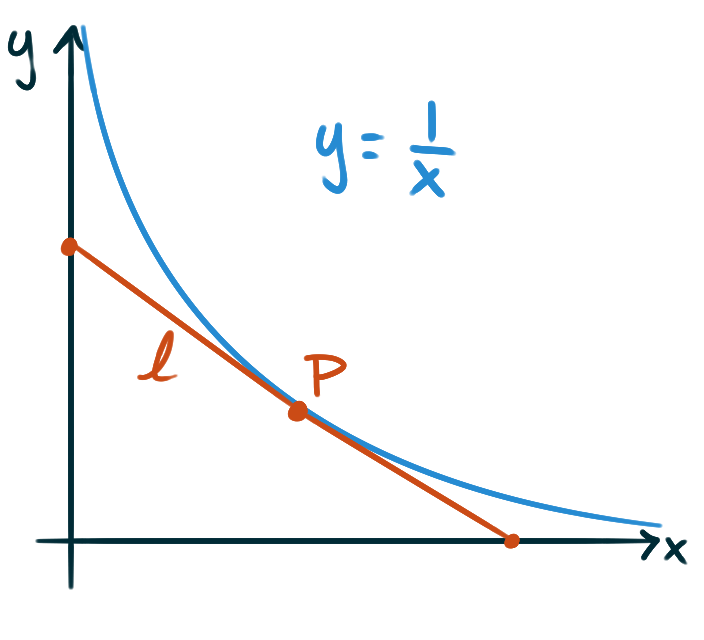- A drag race, commonly called a pass, is run on a \(1320\) ft (¼ mile) long track. Suppose we have a model for how far the dragster has travelled from the starting line for any time \(t\) after it started the pass until \({t=10}\) seconds when it crossed the finish line given by a function \({ f(t) = t^3 + 32t\,.} \) How fast was the dragster going exactly five seconds into the pass?
- A small child on the roof of the Empire State Building hurls a penny towards the city streets below. The height of the penny, in feet, after \(t\) seconds (ignoring air resistance) can be modelled by the function \({f(t) = 1250 - 42t - 5t^2\,.}\) At what speed does the penny hit the ground?
-
What is a formula for the derivative of each of the following functions?
\( \displaystyle \alpha(t) = -3t^3 -2t^2 + t^{\pi^2} - \frac{1}{3t^6} - 4.5\)\( \displaystyle \beta(x) = \sqrt{x}+\sqrt[3]{x}+\sqrt[3]{x^2}\) - What are the values of \(\ell'(1)\) and \(\ell''(3)\) for the function \(\ell\) defined as follows? \[\ell(\omega) = 3.11\omega^{5.809}-17\omega^{-0.1}\]
- The function \(A\) with formula \( A(r) = \pi r^2\) returns the area of a circle given its radius. What is a formula for the derivative \(\frac{\mathrm{d}A}{\mathrm{d}r}?\) This formula should look familiar. Is there a reason for this, or is it just a coincidence?
- The function \(V\) with formula \( V(r) = \frac{4}{3}\pi r^3\) returns the volume of a sphere given its radius. What is a formula for the derivative \(\frac{\mathrm{d}V}{\mathrm{d}r}?\) What do you suppose the formula for \(\frac{\mathrm{d}V}{\mathrm{d}r}\) could represent? Do some quick research; is your speculation correct?
- Take the derivative of the following function two different ways: first by using the product rule straight-away, then again by multiplying the factors before you take the derivative. Verify that the results are equivalent. \[f(x) = \left(x^2-7x\right)\!(4x-5)\]
- Demonstrate how to calculate the derivative of this function two ways: once by directly using the quotient rule, and again by rewriting the expression first to avoid using the quotient rule entirely. \[h(t) = \frac{\sqrt{t}-2t}{t^3}\]
- Take the derivative of the following function two different ways: first by using the quotient rule straight-away, then again by first doing polynomial long division before you take the derivative. Verify that the results are equivalent. \[g(x) = \frac{2x^3-17x^2+23x-8}{2x-3}\]
- What is an equation of the line tangent to the graph of the function \({f(x) = \frac{1}{2}x^2-3}\) at the point where \(x = 2?\)
- The curve defined by the equation \(y = \frac{1}{x^2+1}\) is called the witch of Agnesi. What is an equation for the line tangent to this curve at the point where \(x = 1?\)
- At what point(s) does the line tangent to the curve \(y = \sqrt{x}\) have slope \(18?\)
- At what point(s) on the curve \(y = x^3 - 6x^2 -63x +99\) will the tangent line be perfectly horizontal?
- What is the value of this limit? \[\displaystyle \lim_{h \to 0}\frac{(3+h)^{17}-3^{17}}{h}\]
- You know the product rule \((fg)' = f'g + fg'\), but what about the derivative of the product of three functions? Considering the products “two at a time” find a formula for the derivative \((fgh)'\) for functions \(f,\) \(g,\) and \(h\).
- You’ve been asked at least once now to find an equation of the line tangent to a curve at a point. Let’s “formula-ize” this task. Given a general function \(f(x)\), what’s an equation in terms of \(f\) and \(f'\) for the tangent line to the graph \(y = f(x)\) at the point \(\bigl(c,f(c)\bigr)?\)
-
Find the unique pair of values \(a\) and \(b\) for which the piecewise-defined function \(j\) will be differentiable. \[ j(x) = \begin{cases} 2x^2-1 &\text{ for } x\lt1\\ ax+b &\text{ for } x\geq 1 \end{cases} \]
-
 Consider the hyperbola
defined by the formula \(y = \frac{1}{x}\) for \(x \gt 0\).
Let \(P\) be a point on the hyperbola,
and let \(\ell\) be the line segment
tangent to the hyperbola at \(P\)
with endpoint on the \(x\)- and \(y\)-axis respectively.
Consider the hyperbola
defined by the formula \(y = \frac{1}{x}\) for \(x \gt 0\).
Let \(P\) be a point on the hyperbola,
and let \(\ell\) be the line segment
tangent to the hyperbola at \(P\)
with endpoint on the \(x\)- and \(y\)-axis respectively.
- Show that, regardless of its location on the hyperbola, the point \(P\) will be the midpoint of \(\ell.\)
- Show that the area of the triangle that \(\ell\) cuts off in the first quadrant is invariant per choice of \(P.\) I.e. the area doesn’t change if you move \(P.\)
- James Stewart Find two points on the curve defined by the equation \(y = x^4 - 2x^2 - x\) that have a common tangent line.
- The curves \(y = 1-x^2\) and \(y = x^3\) intersect at a single point. Find the angle at which they intersect.
- Consider the parabola \(y = (x-1)^2+1.\) How many lines are there that pass through the origin and are tangent to this curve, and what are the slopes of those lines?
-
We’ve been taking the power rule, the theorem that gives us the formula \[\frac{\mathrm{d}}{\mathrm{d}x} x^n = nx^{n-1}\] for all integers \(n\), as a fact. But this fact is not manifest. It follows from the definition of the derivative as a limit. Use the definition of the derivative to prove that the power rule is true. Hint: you may need to familiarize yourself with the binomial theorem to prove this.
Does the proof you wrote work if \(n\) is a rational number? What if \(n\) is an irrational number?
- Similarly, the product rule \[ \frac{\mathrm{d}}{\mathrm{d}x} (fg) = f'g+fg' \] is not simply manifest. Use the definition of the derivative to prove the product rule for taking derivatives.